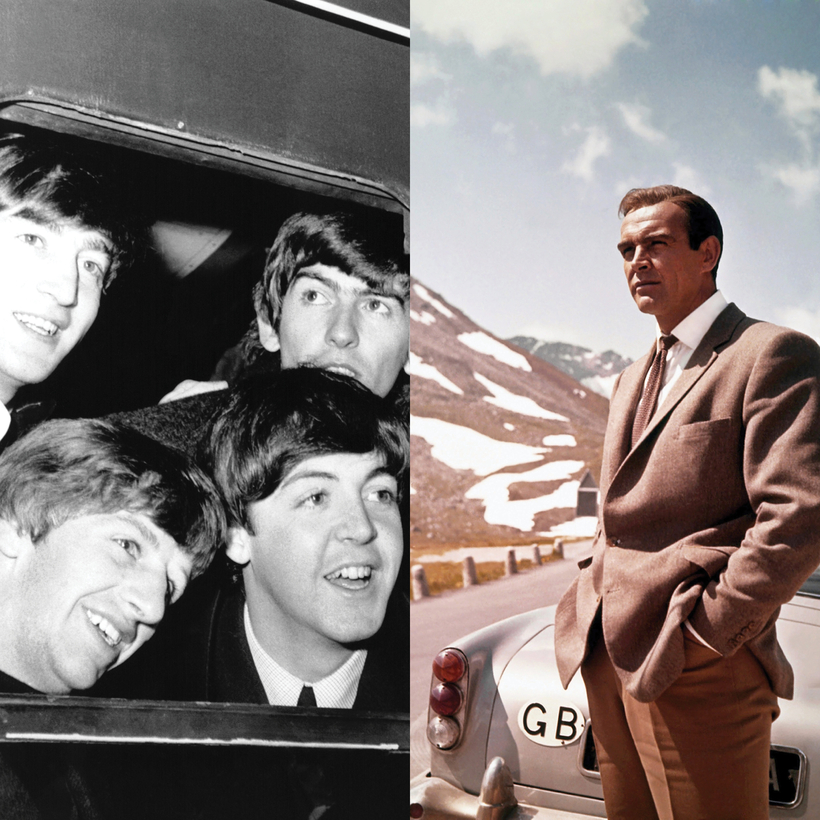Hiding between the covers of Love and Let Die is a smart and lively 5,000-word essay on, as the subtitle promises, James Bond, the Beatles, and the British Psyche. John Higgs’s book is quite a bit longer, however, running to 466 pages (plus bibliography, endnotes, and index).
If you are a fan of Bond and/or the Beatles—a pretty juicy demographic, from a bookseller’s point of view—you will find much to enjoy here. You may learn a few things, too, even if you’re certain you have already read way too much on these two subjects. But tracking Higgs’s argument can feel at times like trying to make sense of the plot of an actual Bond movie, and without adrenalized action sequences to power you past the bloat and head-scratchers.
Higgs’s thesis is simple and pretty inarguable: the Beatles and Bond, both unprecedentedly popular, represented a yin and yang of 1960s British culture, pop or otherwise. The spy movie franchise, despite fetishizing high-tech gadgets and pioneering a bracingly casual approach to both sex and murder, served as an avatar for the nation’s clubby, hierarchical establishment; the band, despite its members’ affection for Victoriana, music-hall sing-alongs, and bus tours, became a force for cultural revolution. “If the question that post-imperial Britain needed to answer was when we should hold on to the traditional, and when we should embrace the new,” Higgs writes, “then Bond and the Beatles gave us very different answers.”

Snobby 007 initially had the upper hand. In 1964’s Goldfinger, he feels entitled to lecture a conquest: “My dear girl, there are some things that just aren’t done, such as drinking Dom Pérignon ’53 above the temperature of thirty-eight degrees Fahrenheit. That’s just as bad as listening to the Beatles without earmuffs.”
The group itself, Northerners with their faces perhaps still pressed against London’s toniest windows, seems to have been a bit in awe of their fictional elder. During an interview promoting their first film, A Hard Day’s Night, also released in 1964, Paul McCartney modestly deemed the picture “O.K.” John Lennon cut in: “It’s not as good as James Bond, though, is it?” McCartney readily agreed: “Oh, not as good as James Bond.”
Like any other 007 fan with excess pocket money, McCartney bought himself an Aston Martin after the one in Goldfinger and, for his apartment, the kind of electric curtains that might grace a Bond villain’s lair, though the curtains never really worked. (“They’ve got a lot to answer for, those James Bond movies,” he complained years later.)
The group’s second movie, Help!, was a larky spy spoof that fell flat; they were playing in someone else’s sandbox.
Snobby 007 initially had the upper hand.
Yet, by 1969, the balance of power had shifted.
On Her Majesty’s Secret Service featured a Bond who grew his sideburns halfway to his earlobes, allowed his hair to graze his collar, and wore a flouncy neck ruff (later adopted by Austin Powers). The spy, Higgs writes, was now “trying to catch up, desperately trying to fit into the world [the Beatles] had shaped.” Four years later, when McCartney agreed to write the theme song for 1973’s Live and Let Die, it was close to an act of noblesse oblige.
Bond is still with us, of course, though the filmmakers and their marketing partners must now take ritual pains to insist he is no longer an avatar for toxic masculinity. Higgs includes an amusing string of quotes from four decades’ worth of actresses, up to and including Ana de Armas, each insisting that hers is not “a typical Bond girl.” For their part, the Beatles have to live down “Run for Your Life” (“Well, I’d rather see you dead little girl/Than to catch you with another man”), but at least they aren’t the Rolling Stones.
Higgs, who has published two books on William Blake and one on the 90s club band the KLF, isn’t here for merely another romp through well-trampled fields of baby-boomer nostalgia. He sees the Beatles-Bond divide as something fundamental and profound. Think of a fight card with “All You Need Is Love” on one side and License to Kill on the other.

As the author explains, “According to Freudian psychologists, love and death are the two central opposing drives in the human psyche…. Love or Eros was the instinct towards life, co-operation and pro-social behaviour, and the desire to open yourself up and become part of something larger. The death drive or Thanatos, in contrast, was the self-destructive pull towards aggression, cruelty and risky behaviour.” Thus the battle for cultural supremacy in postwar Britain mirrors the primal struggle inside each and every one of us—I guess?
It’s not that I think Higgs is off base. It’s just that this feels like a lot of freight to dump onto a pop band and a make-believe secret agent, no matter how many millions upon millions of records and movie tickets sold. Me, I’m here for the fluffier bits. For instance, Higgs, who delights in parallels, points out so many odd coincidences between Bond’s story and the Beatles’ that you’d think he was writing about Lincoln and Kennedy:
- The first Beatles record, the single “Love Me Do,” and the first Bond movie, Dr. No, were released on the same day in the U.K.—October 5, 1962.
- The Goldfinger soundtrack album knocked A Hard Day’s Night off the top of the U.S. album charts. Both movies were released by United Artists, and both featured the actress Margaret Nolan in small roles.
- The most lavish and fantastical Beatles album, Sgt. Pepper’s Lonely Hearts Club Band, was released just three weeks before the most lavish and fantastical Bond film, You Only Live Twice.
- In the same year, 1969, McCartney married Linda Eastman, John Lennon married Yoko Ono, and George Lazenby’s James Bond married Diana Riggs’s Contessa Teresa di Vicenzo (in On Her Majesty’s Secret Service).All three marriages ended with the death of a partner.
- Bond’s biggest enemy was the “cruel, murderous” criminal organization SPECTRE. McCartney’s biggest enemy, at least in 1970, was the “cruel, murderous” American record producer Phil Spector, who, three decades before he killed the actress Lana Clarkson, offended McCartney by adding gloppy strings to “The Long and Winding Road.”
And so on.
A problem with Love and Let Die is that by the halfway mark, the 60s have ended, the Beatles have broken up, Sean Connery has quit Bond, and Higgs’s point has been made—and still he presses on.
He includes a long, somewhat speculative analysis of Lennon and Ono’s complicated marriage, and Lennon’s sidebar with their assistant, May Pang, none of which has much to do with Bond movies. George Harrison’s marriage to Pattie Boyd gets shorter shrift but leads to a discussion of her second husband Eric Clapton’s racism, which leads to David Bowie’s mid-70s flirtations with Fascism, which leads to Pink Floyd’s solipsism—none of which has much to do with Bond, either.

Soon come dozens of pages on Vladimir Putin and contemporary Russia—this is relevant because Bond once fought the Soviet Union, and because Putin once attended a McCartney concert in Red Square where Paul played “Live and Let Die,” and because Higgs credits the Beatles with undermining totalitarian Soviet culture with songs that were “like a gulp of freedom,” to quote Putin himself.
Tellingly, at the Red Square concert, the Russian president refused to sing along with the “Nah nah nah nah nah nah”s in “Hey Jude.” All of which is interesting—I think Higgs is arguing for the Beatles’ brand of soft power over the hard kind embodied by Bond—but I’m not sure it justifies further attention to Russia’s meddling in America’s 2016 presidential election. And we still have more than 50 pages to go.
“Don’t leave me waiting here,” as someone once sang. “Lead me to your door!” (Exclamation point mine.)
I eventually chose to read Love and Let Die not as a book-length argument or critical history but rather as a rambling, loosely organized, periodically delightful compendium devoted to two subjects I’m very fond of.
Did you know that a suggested tagline for the 1983 movie Octopussy was “Eight arms to hold you”—which was also the working title of Help!?
Did you know that the original Bond producers, Albert R. “Cubby” Broccoli and Harry Saltzman, were offered the chance to produce A Hard Day’s Night but turned it down to work with a more established film star? As Saltzman allegedly put it, “Would you rather make a film with four long-haired schnooks from Liverpool who nobody’s ever heard of, when we’ve got Bob Hope?”
Alas, whatever jokes Hope inevitably cracked over the years about either Bond or the Beatles are not here recorded.

Bruce Handy is a journalist and the author of Wild Things: The Joy of Reading Children’s Literature as an Adult


